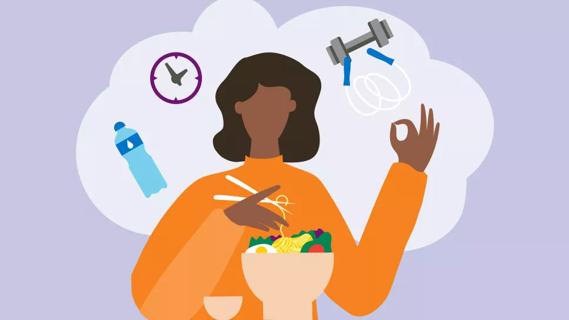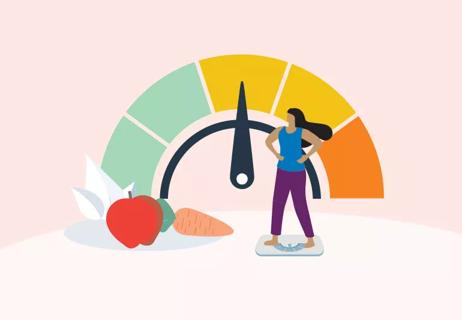If you put on weight during the pandemic, you're not alone

As the COVID-19 vaccine rollout continues, the weather turns warmer and we see the light at the end of the pandemic tunnel, it’s also a time of renewed interest in setting new health goals.
Advertisement
Cleveland Clinic is a non-profit academic medical center. Advertising on our site helps support our mission. We do not endorse non-Cleveland Clinic products or services. Policy
Many of us found our diets going a bit awry and workout routines disrupted throughout the pandemic. Plus there was an emotional component, the stress of the pandemic taking a toll on us all in different ways.
So as we come out of the pandemic, how can we establish new, healthier routines? What’s the best way to lose the weight we’ve gained during the pandemic? And where should our focus be as we start?
We spoke with psychologist and weight management specialist Leslie Heinberg, PhD, to get the answers.
The first thing to understand, says Dr. Heinberg, is that a lot of us are in the same boat. “We’re now seeing the data and people did gain weight during the pandemic,” she says. “One study showed bout one-quarter of people whose BMI is in the ‘normal’ range gained weight as did one-third of people whose BMI classifies them as ‘having obesity.’”
Similar results from other studies show this has been a wide-scale issue during the pandemic so you’re not alone. “There’s a lot of thinking by people that, ‘Oh, everyone else was training for a marathon and look what happened to me,’” says Dr. Heinberg. “But that’s not the case at all. We’ve all been facing similar struggles.”
The pandemic has brought about a series of lifestyle changes for many that are both good and bad, she says.
Advertisement
“With the pandemic, we’ve seen data that shows people were eating much less fast food, doing more cooking at home and eating with their families more. And when you cook at home, you tend to have healthier eating habits,” she notes.
That also applies to alcohol. “During the pandemic, people have been less likely to go to bars or go to restaurants and drink,” she says. Alcohol also lowers inhibitions and so can lead to more food intake, especially at a restaurant. “That’s why restaurants love when you order a drink: You’re more likely to order an appetizer or dessert.”
The flip side, she says, is that with so many of us stuck at home, there’s been more snacking and, with that, consumption of sweets and even sugar-sweetened beverages like soda went up, too.
“When you’re home, you’re where all the food is,” she points out. “That makes it really easy to snack, to have a random cookie.”
And that applies to alcohol, too. “There’s some indication, based on data from earlier in the pandemic, that even if they weren’t going out, people were still consuming more alcoholic drinks,” she notes.
Whether it’s because you’re vaccinated and ready to return to at least a relative feeling of normalcy or because you’re simply ready to get back into the healthy swing of things, there are some key approaches that can help ensure greater success.
Those new habits we just talked about? You can start with those. Says Dr. Heinberg, “Chances are, you’ve established some of those good habits. Keep those habits and try to get away from the bad ones.”
One way to help yourself, she says, is to leave trigger foods behind. “If cookies or chips are your trigger foods, don’t buy those on your next grocery run,” she suggests. “That’s especially important if you’re still working from home, even part-time.”
Some people are able to change their habits and pivot to a healthier lifestyle at the drop of a hat. But not everyone can make that transition at the same pace. In the long run, consistency is of bigger importance than speed.
“Whether it’s a New Years’ resolution or coming out of a global pandemic, we know people are more likely to be successful with behavioral change if they make small, successive goals,” says Dr. Heinberg.
“If you set a really lofty goal like going to the gym every single day, giving up alcohol and ditching fast food, all at the same time, you inevitably fail,” she says. “It’s easy to fall into this all-or-nothing thinking.”
Instead, Dr. Heinberg says, start with goals that are much easier to achieve and act as building blocks for future success. Rather than try to change everything, try one thing, like cutting back on fast food until you’ve successfully given it up. ”Once that’s established,” she points out, “you can add on.”
Advertisement
She compares it running, saying, “You don’t just go from not exercising at all to running marathons. You have to build up, slowly adding just a little bit more each day. Eventually, you get to a point where that success feeds on itself.”
That same small goals approach goes for building a healthy diet, too. “Saying you’re going to eat a good diet is too vague,” Dr. Heinberg says. “There’s no real way to mark that as an achievable goal.”
Instead, she says, make small, specific changes that alter habits for the better and can provide those key building blocks for broader change. Whether it’s packing your lunch for work instead of getting takeout or switching your afternoon pastry snack for fruits and veggies, these are goals that are easy to meet and are not just healthy, but provide positive reinforcement, too.
With gyms closed and exercise classes canceled, the pandemic resulted in a more sedentary lifestyle for many with much less physical activity. One study, using smartphone data, showed that the number of steps taken by health tracker users dropped significantly. “We found ourselves more likely to binge-watch television than to exercise,” says Dr. Heinberg.
With more adults being vaccinated against COVID-19 every day and winter behind us, there should be more opportunities to get out and get active. Even just a 20-30 minute walk every day can have a big impact.
Advertisement
“Again, you should go slow and take measurable steps,” Dr. Heinberg says. “If you go out after a year at home and try to run four miles right away, you might have a horrible experience and not want to continue.”
Instead, focus on those walks during your lunch break or after dinner, maybe even short runs that can build up to longer runs over time.
As we adjust to our changing environment as the pandemic fades, it’s important to remember how much our lives have been altered in the last year. Change is hard and nothing about transitioning back to whatever the new normal is will be easy.
“Humans do not like change and all of the changes the past year were hard and anxiety-producing,” says Dr. Heinberg. “And, yet, while it felt awful at the time, now it feels comfortable. Staying home, staying sedentary, it’s what we’re now used to.”
After all of that, she says, it’s understandable that you’ll feel anxiety about heading back to the gym. “That first time can be really hard and scary,” she says.
But, she adds, we can learn from everything we’ve been through. “If the last year has taught us anything, it’s that we can do really hard things and, even if we don’t like change, we’re highly adaptable.”
Advertisement
Using that experience to provide reinforcement for yourself can be helpful for making these new changes. After everything that we’ve all been through with the pandemic and its challenges, starting a new health routine or even returning to an old one isn’t a big deal.
The big thing to remember, according to Dr. Heinberg, is that there will be ups and downs. “We have to recognize that any time we’re trying to make positive change, it’s not a clear, linear and upward trajectory.”
Whether it’s diet, exercise, or managing stress, there will always be a step back along the way and it’s important to remember to keep your focus on the long term, not just today.
Learn more about our editorial process.
Advertisement

Actively choose healthy habits not only when it comes to food and nutrition, but also physical activity and your mental health

Trying fad diets and skipping meals won’t do you any favors

Wearing this undergarment for too long will do more harm than good

Quick weight loss is possible, but it’s not sustainable

You can lose 15% of your body weight, plus lower your heart disease and diabetes risks

A safe and effective surgery that shouldn’t be considered only as a last resort

Focus on physical activity and foods that pack a nutritional punch to help you lose weight

Skip this unproven, unsafe and unregulated weight-loss practice

Type 2 diabetes isn’t inevitable with these dietary changes

Applying a hot or cold compress can help with pain